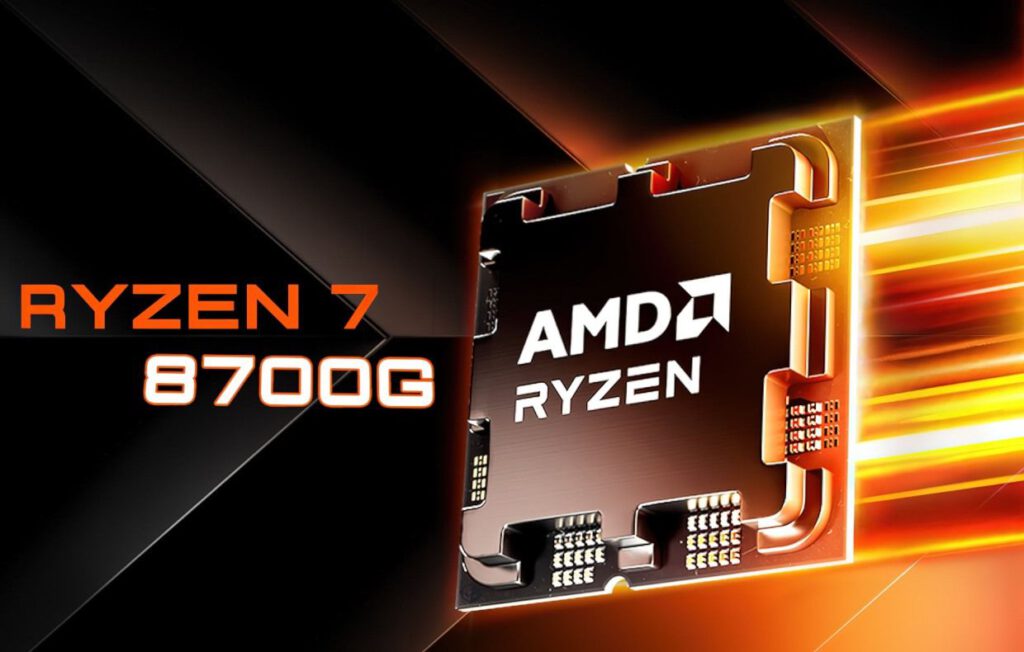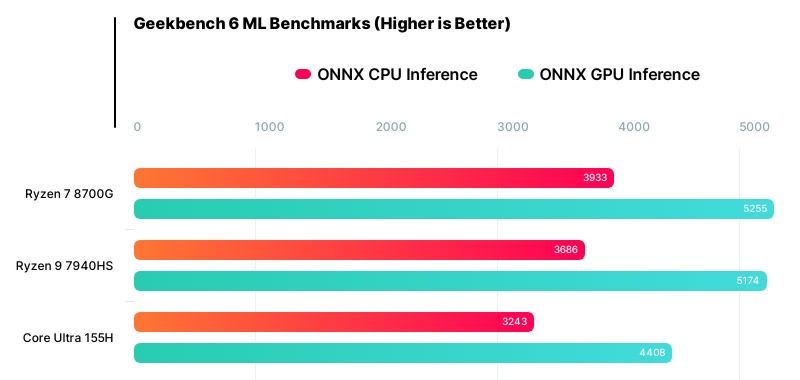The initial tests of the AMD Ryzen 7 8700G have demonstrated its superiority over the Intel Core Ultra 155H. Furthermore, this new product also surpasses the Ryzen 9 7940HS. The computer community had just begun discussing the preliminary cost of the upcoming AMD Ryzen 7 8700G hybrid processor when the results of its first tests appeared online, thanks to the efforts of specialists from the Wccftech resource.
According to available data, the hybrid Ryzen 7 8700G processor belongs to the Hawk Point family and is designed for the Socket AM5 platform. The new product features 8 cores/16 threads with a frequency formula of 4.2/5.1 GHz in nominal/maximum modes, 16 MB of third-level cache memory, and an integrated graphics subsystem based on the RDNA 3 microarchitecture, equipped with 12 compute units operating at ~3.0 GHz.

The Ryzen 7 8700G processor, paired with the X670E AORUS MASTER motherboard from Gigabyte, was tested in Geekbench tasks related to machine learning: in the ONNX CPU Inference discipline, the new product scored 3933 points, and in the ONNX DirectML Inference subtest, which uses the graphics subsystem, it scored 5255 points, outperforming its Intel counterpart, the Core Ultra 155H, by 21.3% and 19.2%, respectively.
When comparing the results of the hybrid desktop Ryzen 7 8700G processor with the capabilities of the previous generation’s mobile model, the Ryzen 9 7940HS, the advantage was also predictably in favor of the newcomer: in the ONNX CPU Inference and ONNX DirectML Inference subtests, the new model was more performant by 6.7% and 1.6%.
Ryzen 8700g processor detailed specifications
Unfortunately, it remains a mystery whether the updated XDNA architecture AI engine was involved in these measurements, which, according to available information, significantly outperforms its predecessors.
It is expected that the first representatives of the Ryzen 8000G series will debut in February next year, so in the near future, we should expect more ‘leaks’ illustrating the performance level of the upcoming products.”

Additional Information:
- AMD Ryzen 7 8700G’s Positioning: This processor is part of AMD’s strategy to offer high-performance options for both desktop and mobile platforms, competing directly with Intel’s offerings.
- Comparison to Intel Core Ultra 155H: Intel’s processor is likely designed for similar use cases, such as high-performance computing and gaming. The Ryzen 7 8700G’s lead in the tests indicates AMD’s progress in these areas.
- Significance of ONNX Tests: ONNX (Open Neural Network Exchange) is a format for AI models. Its use in testing suggests that the Ryzen 7 8700G is optimized for AI and machine learning tasks, which are increasingly important in both consumer and professional computing.
- Importance of RDNA 3 Architecture: RDNA 3 is AMD’s latest microarchitecture for graphics. Its inclusion in the Ryzen 7 8700G’s integrated GPU suggests significant graphics performance, potentially reducing the need for discrete graphics cards in some applications.
- XDNA Architecture: The mention of an “updated XDNA architecture AI engine” suggests AMD might be working on enhancing AI processing capabilities. This could make the Ryzen 7 8700G particularly suitable for AI-driven tasks.
- Market Release and Anticipation: The Ryzen 8000G series, including the Ryzen 7 8700G, is highly anticipated. Its release could shift the competitive landscape in the processor market, especially in segments that demand high performance and AI capabilities.
The AMD Ryzen 7 8700G is a notable processor in AMD’s lineup, characterized by its high performance and advanced features. Here is a detailed overview based on multiple sources:
- Core and Thread Configuration: The Ryzen 7 8700G is an 8-core, 16-thread processor. This configuration signifies its capability to handle multi-threaded applications and multitasking efficiently.
- Clock Speeds: It has a base clock speed of 4.2 GHz and can boost up to 5.1 GHz. Clock speed is a critical factor in determining the raw processing power of a CPU, and these speeds suggest that the Ryzen 7 8700G is tailored for demanding applications and workloads.
- Cache Memory: The processor comes equipped with 16 MB of L3 cache and 8 MB of L2 cache. Cache memory plays a vital role in a CPU’s performance by storing frequently accessed data for quick retrieval. A larger cache can significantly improve processing efficiency, especially in repetitive tasks.
- Thermal Design Power (TDP): The Ryzen 7 8700G has a TDP of 65W. TDP indicates the maximum amount of heat generated by a processor that the cooling system is required to dissipate under normal operating conditions. A 65W TDP is relatively moderate, suggesting that the CPU can deliver high performance without excessive heat generation.
- Integrated Graphics Processing Unit (iGPU): This processor features the Radeon 780M iGPU, which includes 12 compute units (CUs). The presence of an iGPU is particularly beneficial for systems without a discrete graphics card, as it enables basic graphic tasks and supports displays directly from the CPU.
- Succession and Architecture: The Ryzen 7 8700G is a direct successor to the Ryzen 7 5700G “Cezanne” and features the “Zen 4” CPU architecture. “Zen 4” is AMD’s latest microarchitecture, offering improved performance and efficiency over its predecessors.
- Performance in Benchmark Tests: The Ryzen 7 8700G has been tested in various benchmarks and has shown promising results, particularly in comparison with other CPUs in its category. Its performance in AI-related tasks and machine learning benchmarks like Geekbench’s ONNX tests indicates its suitability for advanced computational tasks.
In conclusion, the AMD Ryzen 7 8700G is a high-performance processor with advanced features suitable for a wide range of applications, from gaming to professional workloads. Its integration of Zen 4 architecture and Radeon 780M iGPU makes it a compelling choice for users seeking a balance between processing power and integrated graphics performance.

